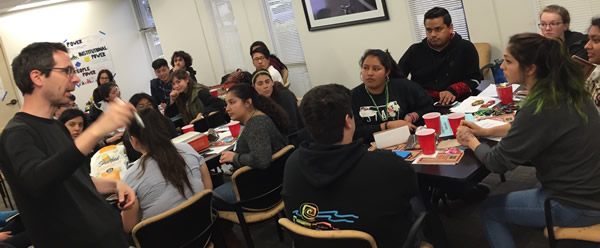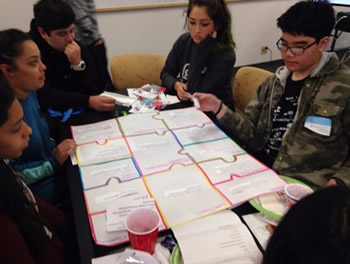Youth leaders from Half Moon Bay and South San Francisco join forces at the innovative School for Public Transportation Reform with the goal of understanding public transit challenges to access/affordability, key transit decision-makers in San Mateo County and the political history of public transit in the Bay Area. This learning is facilitated by Urban Habitat and YLI.
SVCF’s grantmaking program devoted to building strong communities addresses some of the toughest problems in the Silicon Valley region: finding ways to create more affordable housing, and improving transportation and transit systems so that people can get around more efficiently and affordably, benefiting both their lives and the local economy.
To further those goals, SVCF funded several organizations in the Transportation Justice Alliance (TJA) in 2015, a Santa Clara County coalition of transportation advocates, representatives from labor and organizations that represent low-income communities. The TJA includes several SVCF grantees such as TransForm, Working Partnerships USA, Urban Habitat, Sacred Heart Community Services, and People Acting in Community Together; they worked with their own members and transit riders to form a voice for low-income transit riders.
This year, SVCF is providing funding to Youth Leadership Institute, Urban Habitat and San Mateo County Union Community Alliance to start a similar coalition, called the Transportation Equity Allied Movement Coalition (TEAMC) for San Mateo County. The coalition will bring local organizations together to work on a transportation policy that would ensure that SamTrans, the local transit agency, is providing quality transit service for the most disadvantaged riders in San Mateo County – 19 percent of whom are youth.
One of the first organizations to begin work on the goals for TEAMC is Youth Leadership Institute (YLI). YLI’s overall mission is to build communities where young people and their adult allies come together to create positive social change. YLI has established a clear vision for effective and affordable transportation by amplifying the voices of those most impacted: people of color.

Bob Allen, staff member from Urban Habitat, provided training and technical assistance to YLI youth leaders at the School for Public Transportation Reform in San Mateo County in early March.
San Mateo County’s transportation problem was the perfect project for YLI’s students, says Montzerrat Garcia, YLI’s transit lead.
“Locally and countywide, transit riders – including youth, seniors, low-income, and transit-dependent communities – are realizing that investing in public transportation today will lead to multiple health benefits and decongested highways tomorrow,” she says. “Without the vital partnership between local and countywide decision makers and the transit riders most affected, we cannot create a healthier and more equitable San Mateo County.”
YLI’s transportation goals include reducing traffic congestion and pollution-causing emissions, increasing physical activity for community residents, improving access to basic medical needs, improving access to education and employment and improving access to basic medical needs and healthy food options. To alert communities about the transportation concerns affecting the county’s youth, YLI enlists student participants through connections with local school districts and designs programs that not only address transportation needs, but also teach students how to research and become advocates within their own communities.
Michelle, a TEAMC youth leader in Half Moon Bay, says, “I’ve learned that changing our public transportation system would have many community benefits in Half Moon Bay, such as healthier individuals and having greater access to the Bay Area.”

Students who participate in the TEAMC program – come from Half Moon Bay and South San Francisco high schools across the county. Students contacted city council members via email, attended city council meetings and a meeting of the SamTrans board of directors, where they educated decision-makers about their projects and met one-on-one with city council members, other youth and SamTrans staff.
Pictured at right: YLI youth leaders from Half Moon Bay conduct research and assess the local conditions regarding public transportation in their community.
Maritza, a TEAMC youth leader in South San Francisco, says that her work with YLI “taught me that although we all come from different cities, the same issues regarding transportation unite us.”
Although a robust group, YLI’s youth groups have faced some tough lessons along the way. For example, it has been challenging to connect with local decision-makers during an election year when the community has other critical community priorities; and students have learned that although community leaders might be accessible, they have limited power to influence transportation decisions, because most transportation issues are controlled on a regional or county level.
However, despite those challenges, YLI has accomplished much in its quest for easier transportation options. The organization’s leaders say students have succeeded in their research and data-collection efforts, helped build partnerships with other stakeholders, and have increased their own leadership skills.
“There is robust economic development taking place in our region, but also growing inequities, such as access and affordability of public transportation, that are facing the Bay Area and vulnerable populations such as youth. It is critical for youth and other transit riders to have a platform to amplify their needs and be included in the decision-making process that impacts them the most,” said Fahad Qurashi, YLI’s Bay Area director of programs.
Qurashi says among YLI’s next steps are to conduct a countywide survey in partnership with Safe Routes to School coordinators and plan a TEAMC community media event to bring together stakeholders, decision-makers and those who use public transportation the most.
=================
This article was originally published in the Silicon Valley Community Foundation Blog
